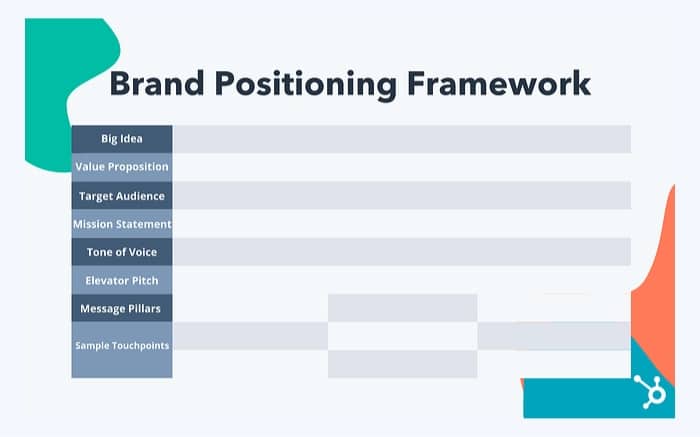The process of positioning your brand in the minds of your clients is called brand positioning. Company positioning goes beyond a slogan or a fancy logo—it’s a strategic approach designed to make your business stand out among competitors. In today’s competitive landscape, especially on platforms like Amazon, brand positioning is crucial in determining success. With the rise of online retail, shoppers now differentiate goods and services from their desktop or mobile devices. Social media platforms, word-of-mouth recommendations, and marketplaces like Amazon all impact a buyer’s purchasing decision, making brand positioning on Amazon just as important as off-Amazon efforts.
The Brand Positioning Definition
Successful brand positioning means that customers perceive your brand as favorable, valuable, and trustworthy. The combination of these three factors becomes exclusive to your brand, so your clients keep a place in their minds for you. It is not enough to be ‘different’ from competitors—you must position your brand by doing something truly outstanding. Everything else is just a comparison. A strong brand positioning strategy ensures your business stands out for the right reasons.
Why Is Brand Positioning Important?
You have a reputation whether you cultivate it or not, so establishing a solid brand positioning strategy is vital. It allows you to take control of your reputation and your brand image. Effective brand positioning enables a business to differentiate itself from competitors, build brand awareness, communicate value, and justify pricing—all of which impact your bottom line. Different businesses will need different brand positioning strategies based on the nature of your offering and business domain. For businesses selling on Amazon, the brand positioning of amazon plays an essential role in gaining an edge in a highly competitive marketplace.
Types of Brand Positioning Strategies
Various brand positioning strategies should be considered when defining how your brand stands out in the market. You’ll want to highlight different competitive advantages depending on your product and audience. Below are some common strategies to help distinguish your brand in a crowded marketplace.
Customer Service Positioning Strategy
Many customers choose retailers or service providers based on their customer service experience. A customer service positioning strategy emphasizes the quality of your support, making it a differentiator. Brands operating in industries known for subpar support can thrive by emphasizing heartwarming and attentive customer service.
The most substantial advantage of this strategy is that excellent customer service may help you justify a higher price. For instance, Apple’s items are costly, but its support team is friendly and responsive.
These service interactions are also essential parts of the flywheel—an initially dissatisfied client can turn into a promoter if they have a positive customer experience.
Be careful with this strategy. If you advertise extraordinary customer service but do not deliver, you will spark negative feedback, social network callouts, and other complaints.
Convenience-Based Positioning Strategy
A convenience-based brand positioning strategy emphasizes why your product or service is easier to use or access than competitors’ offerings. This could involve location advantages, user-friendly features, wide availability, or omnichannel support. Busy customers, in particular, are drawn to brands that make their lives easier, and convenience can also justify higher prices. However, providing such convenience can sometimes be costly, especially if it requires significant investment in customer support or technical infrastructure, such as in the case of SaaS companies that offer multi-platform compatibility.
Price-Based Positioning Strategy
A price-based positioning strategy is one of the most direct ways to position your brand. By offering the lowest price, you can attract price-conscious buyers. This approach works well for brands looking to create an extensive customer base by positioning their products as the most affordable option on the market. However, positioning your brand purely based on price can lead to risks, such as lower perceived quality or entering into price wars with competitors. It’s essential to balance affordability with value in your brand positioning strategy.
Quality-Based Positioning Strategy
A quality-based brand positioning strategy highlights the superior quality of your product or service, often justifying a higher price. This strategy works well for brands that target customers willing to pay more for premium materials, exceptional craftsmanship, or higher returns on investment. Businesses that emphasize quality often highlight their use of sustainable practices, small-batch manufacturing, or unique craftsmanship. While this approach may alienate budget-conscious buyers, it can solidify your brand in the minds of those seeking the best in the market.
Differentiation Strategy
A differentiation strategy focuses on positioning your brand based on unique and exceptional qualities compared to your competitors. This brand positioning strategy works well for businesses offering innovative solutions or products. Tesla, for instance, differentiates itself with cutting-edge technology and innovation. However, launching new and untested products can sometimes leave customers needing clarification on their benefits. Thorough research and testing are necessary to ensure the differentiation resonates with your target audience.
Social Media Positioning Strategy
In today’s digital landscape, social media positioning is a powerful strategy that helps brands connect with their audience where they spend their time. This brand positioning strategy is unique because it focuses on choosing the right platforms for your target market. Not every brand needs to be on all platforms—what matters is where your audience is most active. Effective messaging on those platforms can help reinforce your brand’s position both on and off Amazon.
Other Positioning Strategies
Other brand positioning strategies include positioning your brand as the market leader, the first of its kind, or the most well-known. You can also position your product as the solution to a significant problem. Another approach is competitive positioning, where your brand is directly compared with competitors in your advertising campaigns, emphasizing the benefits of your product over theirs. This strategy works well in markets with well-defined competitors.
How to Craft a Brand Positioning Strategy
Developing a brand positioning strategy involves a deep understanding of your brand, your audience, and your competitors. Here are the steps to craft an effective strategy that sets your brand apart in the market.
Define Your Existing Brand Position
Start by defining your current brand position. Identify your target audience and understand their preferences. Then, outline your brand’s mission, values, and what differentiates you from competitors. Summarize your current value proposition, brand image, and brand voice to understand where you stand clearly.
Create a Brand Essence Chart
A brand essence chart helps you visualize what your brand represents to your customers. It includes attributes, advantages, personality, and how your brand makes customers feel. This chart is an essential tool for streamlining your ideas about your brand’s position in a clear and concise way.
Identify and Research Your Competition
Competitor analysis is key to effective brand positioning. Once you’ve identified your competitors, research their products, services, and positioning strategies. Look for gaps in the market where your brand can offer something different. Understanding your competitors helps you refine your own brand positioning strategy to gain a competitive advantage.
Determine Your Unique Value Proposition
After completing your competitor research, you’ll likely notice patterns of strengths and weaknesses. Your unique value proposition is what sets your brand apart—this is the key advantage that your brand offers that competitors cannot. Your value proposition is critical in developing a strong brand positioning strategy.
Build a Brand Positioning Framework
A brand positioning framework provides a top-down approach to positioning your brand. Start with a big idea about what your brand stands for and narrow it down to specific touchpoints, such as social media captions, blog post titles, and advertising copy. This framework helps ensure your messaging is consistent across all channels.
Create and Test Your Positioning Statement
Your brand positioning statement is a brief declaration describing your brand’s unique value and how it differs from competitors. To create an effective statement, answer these four questions: Who is your target audience? What category do your products or services fall into? What is the greatest benefit of your product? What evidence supports this benefit? Once crafted, test your statement to ensure it resonates with your audience.
Establish an Emotional Connection with Prospects
Building an emotional connection with your prospects is vital for creating trust and rapport. This emotional bond helps customers feel connected to your brand and increases their likelihood of becoming loyal clients. Personalizing the sales process to address their specific needs can further strengthen this connection.
Strengthen Your Brand’s Distinctive Features During Sales
During sales, your brand’s distinctive features should be highlighted to remind customers why they should choose you over competitors. Reinforce your brand positioning through clear communication about your product’s benefits and what sets you apart.
Create Value and Align with Customer Needs
The ultimate goal of your brand positioning strategy is to create value for your customers. Align your product or service with their needs and demonstrate how it solves a problem or fulfills a desire.
Ensure Your Customer Service Staff Reflects Your Brand
Your customer service team is often the face of your brand. Ensure that your team embodies your brand’s core values, whether through a lighthearted tone or a more professional approach. Customer interactions should always reflect your brand’s positioning.
10 Branding Tips for Amazon Positioning
Succeeding in a competitive marketplace like Amazon requires a well-defined amazon brand positioning strategy. Below are 10 tips to help your brand thrive on the platform. Implementing these strategies will enhance visibility and differentiate your brand in the crowded Amazon marketplace.
Tell Your Brand’s Story to Connect with Your Audience
A compelling brand story can engage customers and create an emotional connection. Sharing your journey and values helps differentiate your brand on Amazon. By crafting a narrative that aligns with your customers’ values, you can create a sense of loyalty and trust, making your products more appealing.
Define Your Unique Selling Point
Your unique selling point (USP) is what makes your product stand out. Ensure that customers know why your product is different and why they should choose it over others. A clear USP helps create focus in your brand positioning strategy, ensuring that your message is memorable and resonates with your audience.
Listen to Customer Feedback
Customer reviews and feedback are crucial to improving your brand positioning on Amazon. They offer insights into what’s working and what needs to change. By actively listening and responding to customer feedback, you not only enhance your product offerings but also foster trust and credibility.
Simplify Your Messaging: Less Is More
Keep your messaging clear and concise. Overcomplicating your product listings or offering too many choices can confuse customers. Focusing on the core benefits of your product allows your brand positioning to shine through, making it easier for customers to make purchasing decisions.
Customer Experience Should Be a Top Priority
One way to gauge customer experience is to leverage Amazon Account Performance metrics in Seller Central to view factors like shipment and delivery times, responses to clients’ messages, all A-to-Z claims, or any other negative feedback from the seller.
Also, consider thinking through the customer experience journey. Consider the experience from the moment they see your listing and decide to purchase, to the moment they receive the product, and to any email sequence from you asking for feedback and providing support for any problems.
Optimize Your Amazon Brand Content
Optimized content is key to increasing your visibility on Amazon. Ensure your product listings are well-crafted, optimized for SEO, and reflect your brand positioning amazon. High-quality images, detailed descriptions, and keyword optimization help enhance your brand’s presence and appeal.
Leverage Omnichannel Marketing for Greater Reach
If your brand sells on multiple platforms, integrate data from other channels to improve your Amazon marketing strategy. A consistent message across channels can strengthen your brand positioning. You create a unified brand experience that resonates with your target audience across all platforms by aligning your messaging.
Trademark Registration and Amazon Brand Registry
Trademark protection is essential for safeguarding your brand on Amazon. Enrolling in the Amazon Brand Registry helps protect your products from counterfeits and builds consumer trust. Additionally, trademark registration provides legal safeguards, reinforcing the legitimacy and strength of your brand positioning.
Explore Amazon DSP for Targeted Advertising
Amazon DSP (Demand-Side Platform) allows you to target potential customers through display ads, even outside of Amazon. It’s an important part of a strong amazon brand positioning strategy, as it helps you reach new audiences and retarget existing customers effectively. By utilizing Amazon’s rich data, you can create highly personalized ads that drive conversions and strengthen your brand’s visibility across the web.
Stay Up to Date with Amazon Trends
Amazon is constantly evolving and introducing new features and programs. Staying informed about the latest trends ensures that your brand positioning amazon remains competitive and relevant in a dynamic marketplace. By adapting to new tools, features, and programs, you can continually refine your strategy to align with buyer behaviors and maximize your brand’s potential on Amazon.
Successful Brand Positioning Examples
Some of the most famous brand positioning examples have also led to famous advertising campaigns.
- AVIS vs Hertz
Avis lived by the motto “We try harder” for 50 years. They enjoyed being a challenger brand, which made them try their best. This positioning helped Avis rise despite being the second-largest car rental company. The brand stood out in the market through thoughtful partnerships and brand placement.
- McDonalds vs. Burger King
The competition between McDonalds and Burger King is a fantastic example of two styles of brand positioning.
Burger King is a brand challenger with a brash tone of voice and subtle gimmicks aimed at McDonald’s and its products. Its messages have won fans, awards, and customers around the world.
McDonalds is known to be the leader in its category and refuses to respond to Burger King because once they acknowledge them, they do not distance themselves from their competitors.
- Apple vs Microsoft
Apple personalized its product offering with an ad campaign called “I’m a Mac.” By positioning the Mac as newer, cooler, and more casual than the old PC, Apple could position its product and brand as more modern, trendy, and user-friendly than Microsoft.
Final Word
Whether you’re launching a new product, updating your product line, or looking to improve your brand’s perception, redefining your brand positioning is essential. A well-positioned brand can influence every aspect of your business, from customer experience to employee engagement, ultimately driving long-term success. By crafting a unique and effective brand positioning strategy, you can differentiate yourself from the competition, connect with your target audience, and build lasting customer loyalty.
For professional assistance in optimizing your brand positioning on Amazon and beyond, Profit Whales offers expert services tailored to help your brand grow in the competitive Amazon marketplace. Visit Profit Whales to learn more about how we can assist in elevating your brand. If you have any questions or would like personalized guidance, feel free to reach out to us through our Contact Us page. We’re here to help your brand thrive.
FAQ
What is the difference between brand positioning and branding?
Branding refers to the visual elements and overall identity of your company, such as your logo, color scheme, and brand voice. Brand positioning is focused on how your brand is perceived in the market, especially compared to competitors, and is the strategy behind creating that perception.
How can small businesses effectively position their brand on Amazon?
Small businesses can stand out by emphasizing their unique selling points, such as product quality or customer service, and optimizing their product listings for Amazon’s algorithms. By building a clear amazon brand positioning strategy, they can compete with larger brands and attract loyal customers.
How do I know if my brand positioning strategy is working?
You can measure the effectiveness of your brand positioning strategy by analyzing customer feedback, tracking sales performance, and monitoring how your brand is perceived in the market. Consistent growth in these areas is a strong indicator that your strategy is successful.
Can I use multiple brand positioning strategies at once?
Yes, combining different brand positioning strategies—such as emphasizing both quality and convenience—can help you appeal to multiple customer segments. This approach allows you to address various needs and preferences in the marketplace.
How does brand positioning affect customer loyalty on Amazon?
Effective brand positioning on Amazon builds trust and brand recognition, which are key factors in fostering long-term customer loyalty. Customers who consistently associate your brand with quality or value are more likely to return and recommend your products.







